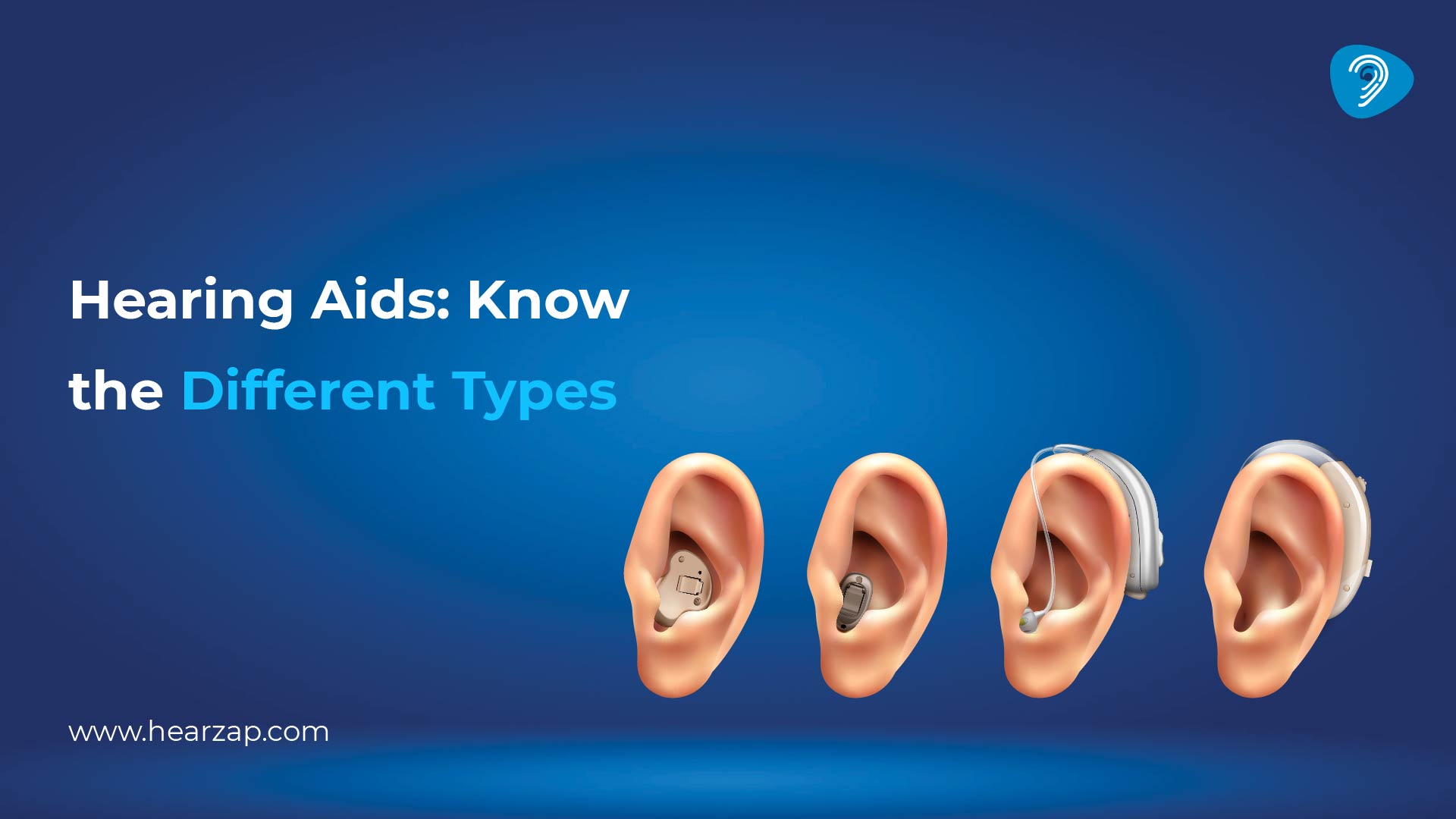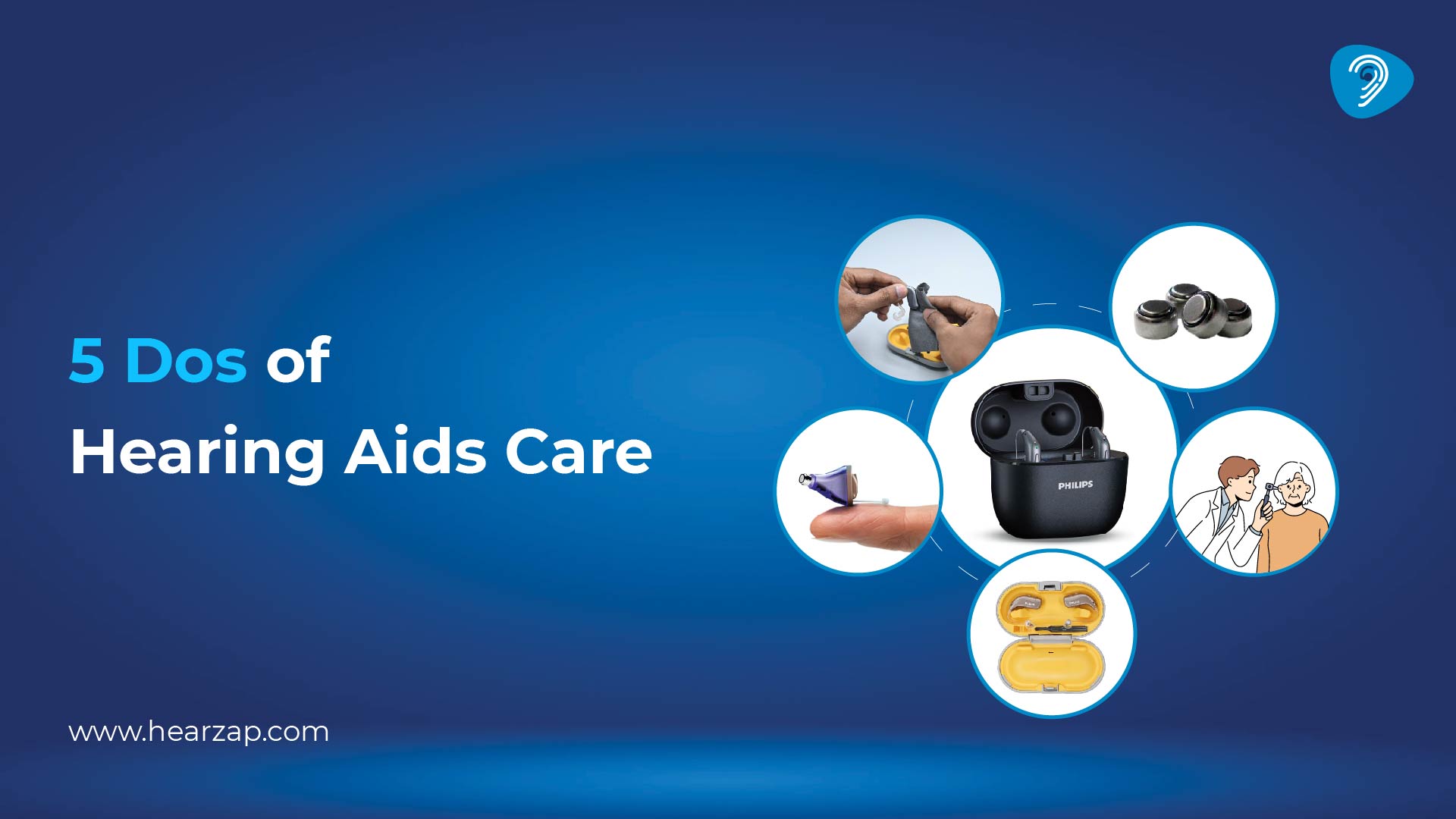HEARING AIDS
Hearing Aids: Know the different types
By Team Hearzap | June 25, 2024

Let's start with the basics and take you through what actually is a hearing aid. A hearing aid or a hearing device, is a wearable electronic device that amplifies sound and assists a person with hearing loss or compromised hearing to hear better. It has a microphone, a microchip(amplifier), and a receiver. A hearing aid helps people improve their hearing ability and make their lives easier.
Do all hearing aids function the same way?
The functioning of the hearing aid depends upon the electronics in the equipment. There are two types of hearing aids, Analog and Digital. Analog hearing aids use older and simpler technology while Digital hearing aids use high-end technology and amplify the sounds correctly according to the different frequency sounds in the environment. The frequencies in the hearing aids will be finetuned by the audiologist based on the degree of the hearing loss of the patient. A trial test with the hearing aid will always help while choosing a hearing aid.
Types of Hearing Aids:
There are 3 main types of hearing aids, and under these three, there are further classifications of hearing aids based on size, style, technology, and power.
Body Level
- Body Hearing Aid
A body-level hearing aid is available in the markets but is rarely used nowadays. These are hearing aids that consist of two main components; the receiver and the speaker, which are long and wired to a tip. The receiver is in the form of a box-like machine that can be placed anywhere in the pocket of one’s clothes.
They can accommodate very large batteries and are easy to maintain thanks to their large size and durability. The only downside to these types of hearing aids is that it collects unwanted noises from the clothes brushing against them and lacks precise directional input to the receiver. Hence, they are now a rarity in today’s world.
Ear Level
Hearing aids that are placed exactly on the ear i.e. on the level of the ear lobe or pinna are called ear level hearing aids. These types of hearing aids can be comfortably used for very high degrees of hearing loss like severe and profound, as they can accommodate larger microchips and batteries. There are 2 kinds of ear level hearing aids; BTE and RIC.
- Behind-The-Ear (BTE) Hearing Aid -
BTE hearing aids rest behind the ear and are connected with a plastic acoustic tube that directs amplified sound into the ear tip or a custom ear mould that is fitted atop the canal. Such hearing aids are best for both children and adults as they are easy to use and access. They are the most suitable kind of hearing aid for people with profound hearing loss.
- Receiver-In-the-Canal (RIC) Hearing Aid-
RIC hearing aids are also a type of behind-the-ear hearing aids that have a receiver placed inside the ear canal rather than behind the ear lobe. The receiver is elongated through a wire and a tip that is placed in the ear canal. These hearing aids consist of a telecoil inside them that tends to provide precise sound adjustment and also provide clearer sound with less occlusion. RIC hearing aids, like BTE hearing aids, can also accommodate larger batteries for prolonged usage.
- Canal Level
Canal level hearing aids are hearing aids that are placed on or inside the canal of the ear. These types of hearing aids are usually smaller and can only be used for sufferers of mild to severe hearing loss. There are 4 kinds of canal level hearing aids, namely, IIC, CIC, ITC, and ITE.
- Invisible In the Canal (IIC) Hearing Aid-
IIC hearing aids are the smallest of all hearing aids and are nearly invisible from the outside. They are fitted deeply into the ear canal. The device is placed in the second bend of the ear canal, hence it appears invisible to anyone. It is the perfect choice for people looking for an ultra-discreet hearing aid for mild to moderate hearing loss.
- Completely In the Canal (CIC) Hearing Aid-
CIC hearing aids are small hearing aids that fit deep inside the ear canal. They are likely to pick less wind noise and are tiny in size. CICs are likely to be 90% invisible from the outside, and only the small handle might be visible from the outside. They are best suited for fashion-conscious individuals with mild to moderately severe hearing loss.
- In the Canal (ITC) Hearing Aid -
ITC hearing aids fit exactly in the entrance of the ear canal making only the small, outer part visible. They have slightly longer battery lives compared to the much smaller CIC and IIC hearing aids. Hence, they can also be used for persons with severe hearing loss. ITC hearing aids have manual controls that are easy to operate in noisy environments.
- In the Ear (ITE) Hearing Aid-
ITE hearing aids are placed in the outer ear and are suggested for mild to severe hearing loss. These are visible from the outside and have options for manual features such as volume control, program button, or telephone switch. Some of the ITE hearing aids come with a telecoil which facilitates improved hearing over the telephone. These hearing aids are easier to handle and fit perfectly well inside the shape of the pinna or the ear lobe.
Related Blogs

5 Dos of Hearing Aids Care

7 Reasons To Upgrade Your Hearing Aid Today
Contact us
We are here for all your hearing needs, from hearing tests to hearing aids. Fill out the form below, and we will give you a call soon.
Please enter a valid mobile number with 10 digits.
Recent Blogs
By Team Hearzap | July 5, 2025
By Team Hearzap | July 4, 2025
By Team Hearzap | July 4, 2025
By Team Hearzap | July 3, 2025
By Team Hearzap | July 2, 2025
Newsletter Subscription
Subscriber to one-stop hearing care newsletter.









